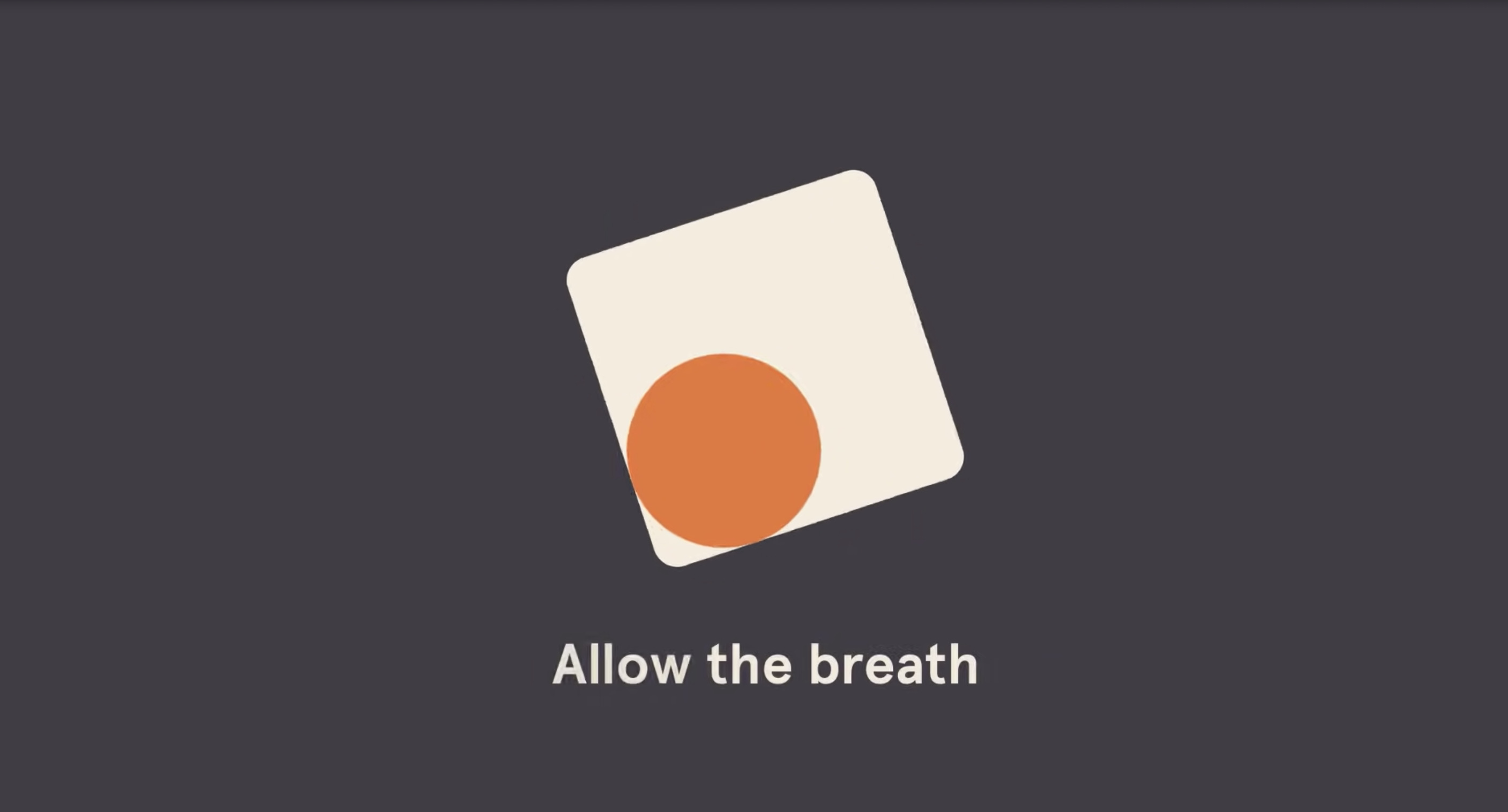Breathing exercises to reduce stress
By Your Headspace Mindfulness & Meditation Experts
Jan 20, 2023
“Take a deep breath” might be some of the best advice around. It’s one of the easiest and most effective ways to relieve stress, and has been for thousands of years. When we take a slow inhale through the nose and a big, long exhale through the mouth, we’re signaling to the brain and body that we’re safe, that it’s okay to calm down. Within a matter of seconds, we start to feel more relaxed.
Most of us rarely need to think about breathing. But learning to pay attention to our breath can improve how we feel and how we behave. Often, taking a moment before we react to stressful situations can make all the difference. With practice, we can purposefully slow down our breath anytime and anywhere until we feel less frazzled and more confident.
Here, we’ll share how to try breathing exercises to reduce stress so the next time we have to give a big speech, hear some disappointing news, or get a case of the Sunday scaries, we’ll know what to do to feel better: breathe.
DISCLAIMER: Please consult your doctor or medical provider to ensure breathwork is suitable for you. Breathing exercises may present a risk of harm for people with certain medical and/or neurological conditions including epilepsy, cardiovascular issues, anxiety and PTSD, or people who are pregnant.
Try a guided meditation

Watch Mini-Meditation: Breathe
1 min
What exactly are breathing exercises?
Breathing exercises, or breathwork, is when we intentionally control how to breathe to experience a sense of relaxation and calm in the mind and body. Anyone who’s taken a yoga class has done breathwork, inhaling and exhaling steadily with each new pose. Or, we may have been prompted to take a few deep breaths during a guided meditation or a Headspace sleepcast. Since breathing techniques aren’t only useful during wellness activities, we can practice them whenever we need them so that we can respond to stress in a more skillful way.
When we get anxious, we likely notice that our breath is shallow and short. We might be breathing through the mouth and only breathing into the top areas of the lungs. That restricts airflow in the body and can cause tense or uncomfortable sensations. Maybe our heart feels like it’s racing, we get sweaty, or we feel tightness in certain areas. So, if we accidentally spill coffee on our shirt during an important work meeting, our rapid breath — a natural response to stress — might actually be making it more difficult for us to clean up, compose ourselves, and settle back into the agenda.
But research shows that deep breathing and other breathwork techniques help us calm down during moments of stress. When we intentionally breath deeper and through the nose, we might notice our breath is pushing out our stomach. This is a sign that our lungs are fully expanding and increasing airflow in the body — that’s just what we want. We’re also activating our “rest and digest” system, which tells the body to relax. Another study shows that deep-breathing exercises may help us improve our focus so that we can pay attention to our reactions and be more present (not caught up in our embarrassment or annoyance about that spilled drink).
How do I practice deep breathing exercises?
Just like meditation, deep-breathing exercises can be done anywhere and anytime. We can use them when we need them, like to shake off the jitters before an interview or first-date, or to feel less irritated when we’re stuck in traffic. But we can also practice breathing techniques regularly, even daily. We can start or end the day with breathwork in bed. We can take deep breaths after our workouts or workdays to help us recover. We can do breathing exercises every time we shower or brush our teeth. Tacking a new habit onto an existing routine makes it easier to add into our day.
The first step to a regular practice is to get comfy. Notice how our body is held and supported by the chair, the mat, or the bed. Just make sure the back and neck are straight to make it as easy as possible to breathe (sit up straight or if laying down, remove any pillows from behind the head). Close the eyes if it feels safe or gaze softly downward.
Now, pay attention to the breath. Is it long? Short? Deep? Shallow? Do we feel it in the nose or throat? Chest or belly? No answer is good or bad in this moment. We’re simply identifying it so we can become more aware of how our breath works and makes us feel. To take our awareness to the next level, we can notice throughout the day where and when we tend to hold our breath and when it feels relaxed.
If we decide that regular deep-breathing exercises are right for us, it’s important to note that we might still feel intense emotional or physical sensations during breathwork. It’s common for tingling to occur in the hands or toes, tightening or other feelings of discomfort in the body, and even changes in body temperature.
If this happens, it’s nothing to fear. We can pause the breathwork and return to normal breathing, bring our focus to an object in the room, stretch gently, or something else that helps to settle the body. Remember: these breathwork instructions are invitations. We can always stop or do something else entirely.
Which breathing exercise is best?
The best and most effective breathing exercises are the ones that work for each of us. Try the different practices and see what techniques and exercises fit. Then, we can use them as tools to help take control of our breath when everything around us feels out of control. In each of the techniques below, repeat for as long as it feels good.
Beginner? Take five deep breaths.
The simplest breathing technique is to count our breaths. Start by counting 1 on the slow inhale through the nose, 2 on the long exhale through the mouth, 3 on the inhale, 4 on the exhale, 5 on the inhale and release.
Use the Headspace app to breathe along to animations of a sleeping cat, fluffy white clouds, gentle waves, and more. We can also set a timer or count a number of breathing cycles on our fingers.
Racing mind? Lengthen each exhale.
Making our exhales longer than our inhales slows down both our heart rate and thoughts. Breathe in slowly through the nose to the count of 3, then exhale through the mouth to the count of 6.
If 3 and 6 are too long, try 2 and 4 breaths. Or to extend the exhale longer, try 4 and 8 breaths.
Anxious? Try belly breathing.
We’re not actually breathing into our belly here, but the belly will puff out when we fill up our lungs. It might be helpful to place a hand on the stomach so we can feel how it rises and falls when we direct our breath there.
Slowly breathe in through the nose and feel the belly push out. Slowly exhale through the mouth and feel the belly draw inwards.
Need to focus? Try box breathing.
For this breathing exercise, it might be helpful to imagine a box and its 4 equal sides. See it? This visualization will help us breathe and hold our breath for the same number of counts while we trace one corner to the next in our minds, all the way around the box.
Taking slow, deep breaths, inhale through nose for 4, hold the breath for 4, exhale through the mouth for 4, and hold the breath for 4 before we inhale again.
Overwhelmed? Try alternate nostril breathing.
This ancient yogic form of breathing is called Nadi Shodhana, or alternate nostril breathing, a method said to balance the left and right hemispheres in the brain and create a peaceful state of mind. This exercise is best to do sitting upright, with a long spine and relaxed shoulders.
Take the right thumb and close the right nostril, inhale slowly and fully through the left nostril, then pause. Use the right ring finger to close off the left nostril. Then release the thumb and exhale through the right nostril. Pause.
Leaving our fingers exactly where they are, we’ll breathe in through the right nostril, then pause. Use the right thumb to close off the right nostril. Then release the right ring finger and exhale through the left nostril. Pause. That’s one full count.
When we’re finished with deep-breathing exercises, we no longer need to breathe intentionally. So we can return to our normal breathing. While the breath is returning to its natural rhythm, take the moment to notice how the body and mind feel after we took the time to practice a little self-care.

Try 18 meditations for stress
Looking for meditations that help relieve stress? A healthier, happier you is a few breaths away.
The Headspace app has a Guided breathwork collection that offers members simple breathing techniques to relax the mind and body. Plus, a Reframe stress and relax collection of meditations and singles, including:
Learn to reframe negative emotions and let them go.
Learn to work with a restless mind more skillfully.
Connect with anger and use it to train your mind.
Train your mind to be more comfortable with change.
Being present helps us leave regret in the past.
Give yourself room to breathe.
Step away from worried thoughts.
Anchor your mind and body in the present.
Let go of whatever’s causing you to feel frustrated.
Bring an unsettled mind back to the subject at hand.
Change your relationship to physical pain.
Step away from stress and into the moment.
Lead your mind to a natural place of rest.
Let go of any tension or busyness in the mind.
Let go of tension and find a little peace of mind.
Recognize what’s occupying your mind and let it go.
Press pause in the middle of your workday.
Find some focus and relaxation during a busy day.
During times of stress and anxiety, don’t forget one of the most effective stress-management tools is right at the tip of our tongue — literally — whenever we need it.
Breathing exercises - simple breathing techniques to relax your mind and body


Be kind to your mind
- Access the full library of 500+ meditations on everything from stress, to resilience, to compassion
- Put your mind to bed with sleep sounds, music, and wind-down exercises
- Make mindfulness a part of your daily routine with tension-releasing workouts, relaxing yoga, Focus music playlists, and more
Annual - billed at $69.99 USD/yr
14 days free
$5.83 USD/month
Monthly
7 days free
$12.99 USD/month


Stay in the loop
Be the first to get updates on our latest content, special offers, and new features.
By signing up, you’re agreeing to receive marketing emails from Headspace. You can unsubscribe at any time. For more details, check out our Privacy Policy.
- © 2025 Headspace Inc.
- Terms & conditions
- Privacy policy
- Consumer Health Data
- Your privacy choices
- CA Privacy Notice










